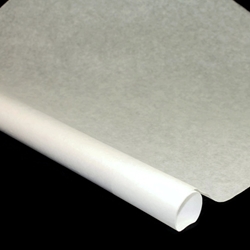Your shopping cart is currently empty.
What is Rice Paper
What is Rice Paper?
When you search online for the term "rice paper" do you have a difficult time finding exactly the paper you need? This is because that term has multiple origins for different types of paper that all have different uses. Here are four completely different types of paper that have different uses but all get called rice paper.
- Paper Made from the Rice Paper Plant: No, there isn't a paper made from the rice plant. Around the turn of the twentieth century, a type of paper made from the Tetrapanax Papyrifer plant, was imported to Europe from Asia. This paper was commonly, yet mistakenly, called "rice paper" due to its Asian origins and its bright white color. This paper is commonly used to make artificial flowers, as a sole for shoes and for painting. However, it is usually not used for writing.
- Edible Paper: In the food industry, there is a edible, thin, starchy paper which is used to wrap Vietnamese finger foods. Often times this food wrapping paper is referred to as rice paper, or nem wrappers. This paper can be made from rice starch, but other ingredients such as tapioca starch, milk, and bananas can be added for flavor and texture.
- Wrapping Rice: In Asia, there is also a paper made from the bark of the Mulberry Tree which is used to wrap up rice bundles for transportation. You can see how this paper is easily referred to as rice paper, even though it is an industrial mulberry paper.
- Rice Paper for Art, Architechture and Writing: Papers from Asian countries are often labelled with the generic term of Rice Paper. The paper can originate in many different countries and is often made with different pulp and fiber ingredients. The most common source of pulp for rice papers is different varieties of the mulberry tree. Other plants like the Lokta bush are also used due to their wide distribution in the country of origin.
If you are looking for a rice paper for art, lampshades, shoji screens or other creative applications, there are several types of paper you may find useful. Below are different types of paper which are often referred to as rice paper:
- Mulberry Paper from Thailand: The Thai people have perfected the mass production of mulberry paper. After carefully preparing the bark strands, artisans hand make mulberry paper is all different sizes and weights. Unryu Paper is soft and translucent while Heavyweight Mulberry Papers provide stiffness and texture.
- Washi Paper from Japan: Washi paper is a highly refined mulberry paper. Japanese craftspeople have elevated common mulberry paper to a fine art. One branch of Japanese paper-making focuses on taking mulberry, mitsumata and gampi papers and crafting them into such high quality to be used in book and document conservation efforts. The conservation papers are free from defects and are so thin, they are virtually transparent when used to repair books. Another branch of Japanese paper-making uses mulberry paper to display intricate , artistic designs. Chiyogami or Yuzen paper features beautiful and colorful designs. Each color of the design is meticulously hand-silkscreened onto the sheet. After 8 or 9 applications of silkscreening, the depth of color is amazing.
- Hanji Paper from Korea: Rice paper from Korea is formally known as Hanji Paper. Hanji paper is traditionally used for legal and important documents that need to last a very long time. Hanji paper achieves this durability by adding Hibiscus meniot to the paper pulp. The meniot provides additional strength to the fibers so that they won't break down over time. The pulp mixture is also free of any acid making the Hanji Paper an ideal archival paper.
- Lokta Paper from Nepal: The Lokta bush is more prevalent in Nepal than the Mulberry tree. Bark from the Lokta bush is used to make paper pulp much the same way mulberry is used in Thailand, Japan and Korea. Nepalese artisans have become famous for not just making paper, but for converting that paper into useful paper products and decorations like bags and rosettes. Like its cousins, Lokta paper often gets mis-named "rice paper."
- Shoji Paper from Japan: Another common usage of rice paper is in architecture. You can find it in Japanese Shoji screens and as a translucent lamp shade. Shoji paper is a thin, semi-translucent mulberry paper that is usually left a natural off-white color or bleached white. It is placed into screen frames and wetted. As the paper dries, it shrinks. Held tight in the screen frame, the paper becomes smooth and tight.
- Xuan Paper from China: Finally, rice paper made in China is called Xuan Paper. It originally was made from the bark of the Pteroceltis Tatarinowii tree (a relative of the Elm tree). Over the years other pulp like mulberry, bamboo and rice made its way into the Chinese paper making industry.
Be sure to browse our extensive collection of papers from all regions of Asia. You are sure to find just the right paper for your project.













